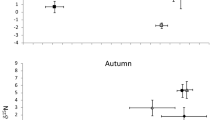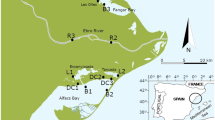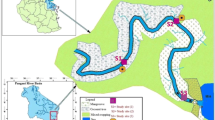Abstract
Salt marshes and shallow-water macroalgal beds are known to provide nursery habitat for many species of fish and invertebrates. The role of these habitats as refuge from predation is well established, but the degree to which indigenous primary production within the nursery provides food for growth and development of estuarine species remains unresolved. In this study, we tested the hypothesis that juvenile blue crabs depend on indigenous primary production, directly or indirectly, during their entire stay within the nursery. To test this hypothesis, we conducted isotopic studies and stomach content analyses of juveniles from habitats near the mouth of Delaware Bay and from an adjacent lagoonal estuary (ca. 39.5° N, 75.1° W). Primary producers, marsh detritus, various life-history stages of blue crabs and potential prey species were sampled in the main estuary and in an adjacent marsh during the summer and early fall of two consecutive years. Newly settled juveniles (<15 mm carapace width) from the marsh were about 1.8‰ lighter in carbon (−17.2‰) relative to larger juveniles from the marsh (15–30 mm carapace width) and appeared to have retained a carbon isotopic signature indicative of the phytoplankton-based food web associated with larval stages. However, the signature of juveniles changed as a function of size. Large juveniles and crabs >60 mm were enriched in δ13C (−14.7 ± 0.1‰) compared to small crabs, suggesting a gradual shift in diet from a planktonic to a detritus-based food web with increasing size. As with crabs from Delaware Bay, the δ13C signature of juvenile crabs sampled from macroalgal beds in the lagoonal estuary (Rehoboth Bay) changed as a function of size. Also, δ13C ratios of crabs varied among the various species of macroalgae. The δ15N composition of primary producers in the marsh and main estuary also was reflected in the δ15N values of crabs and other benthic consumers in the respective habitats. Results of stomach-content analysis in this study were consistent with isotope data. Observed changes in prey preferences were related to changes in size of juvenile crabs and also differed among habitats. Gut content analyses of the three size classes of juveniles in macroalgal beds from Rehoboth Bay indicated that the crabs depend heavily on various amphipod species that occur on the seaweeds. These amphipods graze directly on the macroalgae and are among the most abundant invertebrates in the macroalgal beds. This implies a direct trophic relationship between the juvenile crabs and the macroalgae. In summary, our study provides strong evidence that the value of nursery areas such as salt marshes and macroalgal beds goes beyond that of providing refuge from predation, and that species using these nurseries (e.g. juvenile blue crabs) are ultimately dependent on primary production originating in benthic plants indigenous to the nursery.
Similar content being viewed by others

References
Bardonnet A. and Riera P. (2005). Feeding of glass eels (Anguilla anguilla) in the course of their estuarine migration: new insights from stable isotope analysis. Estuarine, Coastal and Shelf Science 63: 201–209
Bock M. J. and Miller D. C. (1995). Storm effects on particulate food resources on an intertidal sandflat. Journal of Experimental Marine Biology and Ecology 187: 81–101
Cifuentes L. A., Fogel M. L., Pennock J. R. and Sharp J. H. (1989). Biogeochemical factors that influence the stable nitrogen isotope ratio of dissolved ammonium in the Delaware Estuary. Geochimica et Cosmochimica Acta 53: 2713–2721
Cifuentes L. A., Sharp J. H. and Fogel M. L. (1988). Stable carbon and nitrogen isotope biogeochemistry in the Delaware estuary. Limnology and Oceanography 33: 1102–1115
Creach V., Schricke M. T., Bertru G. and Mariotti A. (1997). Stable isotopes and gut analyses to determine feeding relationships in saltmarsh macroconsumers. Estuarine, Coastal, and Shelf Science 44: 599–611
Currin C. A., Newell S. Y. and Paerl H. W. (1995). The role of standing dead Spartina alterniflora and benthic microalgae in salt marsh food webs: considerations based on multiple stable isotope analysis. Marine Ecology Progress Series 121: 99–116
Deegan L. A. and Garritt R. H. (1997). Evidence for spatial variability in estuarine food webs. Marine Ecology Progress Series 147: 31–47
Dittel A. I. (1993). Changes in food-habits of Callinectes arcuatus (Ordway) (Crustacea – Decapoda) in the Gulf of Nicoya, Costa-Rica. Revista de Biologia Tropical 41: 639–646
Dittel A., Hines A., Ruiz G. and Ruffin K. (1995). Effects of shallow water refuge on behavior and density-dependent mortality of juvenile blue crabs in Chesapeake Bay. Bulletin of Marine Science 57: 902–916
Dittel A. I., Epifanio C. E., Schwalm S. M., Fantle M. S. and Fogel M. L. (2000). Carbon and nitrogen sources for juvenile blue crabs Callinectes sapidus in coastal wetlands. Marine Ecology Progress Series 194: 103–112
Dittel A. and Epifanio C. E. (1982). Seasonal abundance and vertical distribution of crab larvae in Delaware Bay. Estuaries 5: 197–202
Epifanio C. E. (1995). Transport of blue crab (Callinectes sapidus) larvae in the waters off Mid-Atlantic states. Bulletin of Marine Science 57: 713–725
Epifanio C. E., Dittel A. I., Rodriguez R. A. and Targett T. E. (2003). The role of macroalgal beds as nursery habitat for juvenile blue crabs, Callinectes sapidus. Journal of Shellfish Research 22: 881–886
Fantle M. S., Dittel A. I., Schwalm S. M., Epifanio C. E. and Fogel M. L. (1999). A food web analysis of the juvenile blue crab, Callinectes sapidus, using stable isotopes in whole animals and individual amino acids. Oecologia 120: 416–426
Fogel M. L., Cifuentes L. A., Velinsky D. J. and Sharp J. H. (1992). Relationship of carbon availability in estuarine phytoplankton to isotopic composition. Marine Ecology Progress Series 82: 291–300
Fry B. (1981). Natural stable isotope tag traces Texas shrimp migrations. Fishery Bulletin 79: 337–345
Fry B., Lutes R., Northam M., Parker P. L. and Ogden J. (1982). A 13C/12C comparison of food webs in Caribbean seagrass meadows and coral reefs. Aquatic Botany 14: 389–398
Garvine R. W., Epifanio C. E., Epifanio C. C. and Wong K. C. (1997). Transport and recruitment of blue crab larvae: a model with advection and mortality. Estuarine Coastal and Shelf Science 45: 99–111
Guest M. A. and Connolly R. M. (2004). Fine-scale movement and assimilation of carbon in saltmarsh and mangrove habitat by resident animals. Aquatic Ecology 38: 599–609
Guest M. A., Connolly R. M. and Loneragan N. R. (2004). Carbon movement and assimilation by invertebrates in estuarine habitats at a scale of metres. Marine Ecology Progress Series 278: 27–34
Haines E. B. and Montague C. L. (1979). Food sources of estuarine invertebrates analyzed using 13C/12C ratios. Ecology 60: 48–56
Hart E. A. and Lovvorn J. R. (2002). Interpreting stable isotopes from macroinvertebrate foodwebs in saline wetlands. Limnology and Oceanography 47: 580–584
Heck K. L. and Thoman T. A. (1984). The nursery role of seagrass meadows in the upper and lower reaches of the Chesapeake Bay. Estuaries 7: 70–92
Hines A. H., Lipcius R. N. and Haddon A. M. (1987). Population dynamics and habitat partitioning by size, sex and molt stage of blue crabs Callinectes sapidus in a subestuary of central Chesapeake Bay. Marine Ecology Progress Series 36: 55–64
Holland A. F., Mountford N. K., Kaumeyer K. R. and Mihursky J. A. (1980). Influence of predation on infaunal abundance in upper Chesapeake Bay. Marine Biology 57: 221–235
Jones M. B. and Epifanio C. E. (1995). Settlement of brachyuran megalopae in Delaware Bay: an analysis of time series data. Marine Ecology Progress Series 125: 67–76
Kraft, J. C., E. A. Allen, D. F. Belknap, C. J. John & E. M. Maurmeyer, 1976. Delaware’s Changing Shoreline. Technical Report Number 1, Delaware Coastal Zone Management Program, May 1976
Laughlin R. A. (1982). Feeding habits of the blue crab, Callinectes sapidus Rathbun, in the Apalachicola estuary, Florida. Bulletin of Marine Science 32: 807–822
Maberly S. C., Raven J. A. and Johnston A. M. (1992). Discrimination between 12C and 13C by marine plants. Oecologia 91: 481–492
Macko, S. A., 1981. Stable nitrogen isotope ratios as tracers of organic geochemical processes. Dissertation, University of Texas, Austin
Macko S. A., Lee W. Y. and Parker P. L. (1982). Nitrogen and carbon isotope fractionation by two species of marine amphipods: laboratory and field studies. Journal of Experimental Marine Biology and Ecology 63: 145–149
Miller D. C., Bock M. J. and Turner E. J. (1992). Deposit and suspension feeding in oscillatory flows and sediment fluxes. Journal of Marine Research 50: 489–520
Miller D. C., Muir C. L. and Hauser O. A. (2002). Detrimental effects of sedimentation on marine benthos: what can be learned from natural processes and rates?. Ecological Engineering 19: 211–232
Montague C. L. (1980). A natural-history of temperate western Atlantic fiddler crabs (genus Uca) with reference to their impact on the salt-marsh. Contributions in Marine Science 23: 25–55
Norris D. R., Marra P. P., Kyser T. K. and Ratcliffe L. M. (2005). Tracking habitat use of a long-distance migratory bird, the American redstart Setophaga ruticilla, using stable-carbon isotopes in cellular blood. Journal of Avian Biology 36: 164–170
Orth R. J. (1987). Utilization of seagrass meadow and tidal marsh creek by blue crabs (Callinectes sapidus). I. Seasonal and annual variations in abundance with emphasis on post-settlement juveniles. Marine Ecology Progress Series 41: 283–294
Pardieck R. A., Orth R. J., Diaz R. J. and Lipcius R. N. (1999). Ontogenetic changes in habitat use by postlarvae and young juveniles of the blue crab. Marine Ecology Progress Series 186: 227–238
Peterson B. J. (1999). Stable isotopes as tracers of organic matter input and transfer in benthic food webs: a review. Acta Oecologica-International Journal of Ecology 20: 479–487
Peterson B. J. and Howarth R. W. (1987). Sulfur, carbon and nitrogen isotopes used to trace organic matter flow in the salt-marsh estuaries of Sapelo Island, Georgia. Limnology and Oceanography 32: 1195–1213
Petrone C. J., Jancaitis L. B., Jones M. B., Natunewicz C. C., Tilburg C. E. and Epifanio C. E. (2005). Dynamics of larval patches: spatial distribution of fiddler crab larvae in Delaware Bay and adjacent waters. Marine Ecology Progress Series 293: 177–190
Stoner A. W. and Buchanan B. A. (1990). Ontogeny and overlap in the diets of four tropical Callinectes sp. Bulletin of Marine Science 46: 3–12
Sullivan M. J. and Moncreiff C. A. (1990). Edaphic algae are an important component of salt marsh food-webs: evidence from multiple stable isotope analyses. Marine Ecology Progress Series 62: 149–159
Timmons M. and Price K. S. (1996). The macroalgae and associated fauna of Rehoboth and Indian River Bays, Delaware. Botanica Marina 39: 231–238
Virnstein R. W. (1977). The importance of predation by crabs and fishes on benthic infauna in Chesapeake Bay. Ecology 58: 1199–1217
Virnstein R. W. (1979). Predation on estuarine infauna: response patterns of component species. Estuaries 2: 69–86
Wainright S. C., Fuller C. M., Michener R. H. and Richards R. A. (1996). Spatial variation of trophic position and growth rate of juvenile striped bass (Morone saxatilis) in the Delaware River. Canadian Journal of Fisheries and Aquatic Sciences 53: 685–692
Wainright S. C., Weinstein M. P., Able K. W. and Currin C. A. (2000). Relative importance of benthic microalgae, phytoplankton and the detritus of smooth cordgrass Spartina alterniflora and the common reed Phragmites australis to brackish-marsh food webs. Marine Ecology Progress Series 200: 77–91
Williams A. B. (1984). Shrimps, Lobsters and Crabs of the Atlantic Coast of the Eastern United States, Maine to Florida. Smithsonian Institution Press, Washington DC, 550
Author information
Authors and Affiliations
Corresponding author
Rights and permissions
About this article
Cite this article
Dittel, A.I., Epifanio, C.E. & Fogel, M.L. Trophic relationships of juvenile blue crabs (Callinectes sapidus) in estuarine habitats. Hydrobiologia 568, 379–390 (2006). https://doi.org/10.1007/s10750-006-0204-2
Received:
Revised:
Accepted:
Published:
Issue Date:
DOI: https://doi.org/10.1007/s10750-006-0204-2



